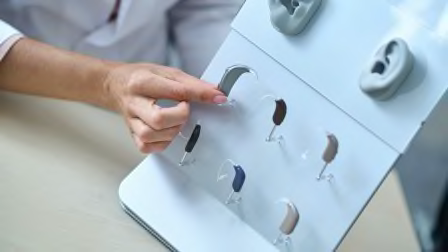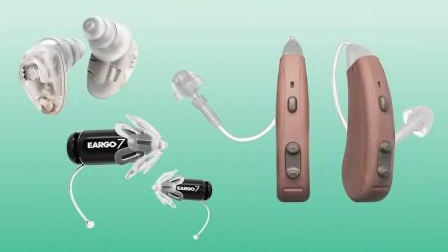Make Your Hearing Aids Work Harder
Certain environments can be especially challenging, even with hearing aids. Here’s how to hear better at concerts, parties, and in other tricky settings.

Prescription eyeglasses can bring you back to 20/20 vision. Hearing aids are helpful, but different: They can’t restore you to perfect hearing. Even the very best hearing aids can’t completely resolve every listening challenge. In our most recent survey-based ratings of hearing aid brands, for example, every single brand we rated earned bottom marks for improving the ability to hear group conversations in noisy environments.
Still, hearing aids can provide enormous benefits in plenty of situations. Making sure your hearing aid has certain features, adding a few key accessories, and using some helpful listening strategies can all help add to the value and benefit your devices provide. You may not get to the equivalent of 20/20 hearing, but with smart shopping, patience, and practice, the right devices can help you participate fully in the world again, even in challenging settings like concerts, restaurants, and parties.
If you’re in the market for new hearing aids or you’re trying to get the most out of the ones you already have, here are the features, upgrades, accessories, and strategies to consider.
At Movies, Lectures, Concerts, and Other Performances
What’s the key hearing aid feature to ask your audiologist or hearing aid dispenser for these situations? A telecoil. That’s a small coil of wire built into a hearing aid that allows it to become a wireless receiver. It’s beneficial because a wide variety of venues across the U.S., including performance spaces, arenas, movie theaters, and courtrooms, are required by the Americans with Disabilities Act to have assistive listening systems (ALS).
At Restaurants and Parties
Noisy get-togethers can be some of the toughest situations for people with hearing difficulties. If your group is reserving a table at a restaurant, find out if you can request one in a quieter part of the restaurant, near a corner or a wall. When you arrive, seat yourself so that your back is to a wall, which means you’ll only be getting sound input from in front of you (and possibly from beside), but not from behind you.
When it comes to hearing aids, consider two key options: some type of specific speech-in-noise program and a noise-canceling feature. The former generally incorporates directional microphones to amplify your speaking partner while dampening noise from other directions, and it can be highly effective, says Jasleen Singh, AuD, an assistant professor of speech, language, and hearing sciences at the University of Massachusetts Amherst. “Any good hearing aid will have this as a standard,” she says.
A noise-canceling feature uses algorithms to help neutralize unwanted noise. The evidence is less clear about its benefit, according to Singh, though it may help make listening easier and more comfortable for some users.
Some accessories can be helpful in this case too, particularly remote microphones you can purchase that feed audio to your hearing aid. You can hand the mic to whomever you’re speaking to so that you can better hear them speak. Some remote mics can also be used in group conversation by placing them on a table in the middle of everyone. Some of these even allow you to designate which directions to amplify.
Of course, remote microphones are another expense on top of the cost of hearing aids. They can cost anywhere from around $200 to more than $2,000 for the most sophisticated mics. They’re also generally made to work with a specific brand of hearing aid, and while they’re usually available for prescription aids, they’re not available for all OTCs (Lexie and Jabra do offer remote microphones for their OTCs.) Still, there’s one more option for a remote microphone. If you have an iPhone and certain kinds of hearing aids (including some OTCs), you can turn your phone into an extra mic with Apple’s Live Listen feature. Find a list of compatible hearing aids at Apple.
When Talking on the Phone
A simple trick that can help you hear phone calls, especially if you’re at home, is to take calls on speaker phone rather than holding the phone up to your ear. After all, Singh says, “we hear better with two ears than one.” You can also set built-in captioning capabilities on your phone, like Live Caption on Google Pixel and some other Android devices, and Live Captions on iPhone.
But the big feature to look for here is Bluetooth call streaming. Plenty of hearing aids, including some OTC models, offer the ability to stream phone calls directly to your hearing aids via Bluetooth. If you’re not comfortable using Bluetooth, ask your audiologist about a phone relay device, which can also stream calls right to your hearing aid.
In Everyday Conversations
Whether you have a hearing aid or not, a few conversation strategies can help facilitate clearer communication, especially when you practice them with the people you speak with most frequently. Here’s what to consider:
Speak face-to-face. Be sure to get your conversation partner’s attention before you start speaking, and make sure you can both see each other’s face when you’re talking. Visual cues can greatly enhance understanding between two people.
Use smart strategies to clarify. Try not to ask a simple, “What?” when you can’t hear what someone has just said. They’re likely to simply repeat, at a higher volume, which can actually distort the message. Instead, try asking for clarification or if the person can rephrase. If you’re on the other end of that question, instead of repeating yourself louder, try rephrasing and enunciating (while maintaining your normal speaking pace). “Shouting doesn’t always help,” says Carolyn Stern, director of outreach and strategic initiatives at the Center for Hearing and Communication, a nonprofit audiology center in New York City. It can exaggerate your facial expressions and make it harder for your speaking partner to pick up on nonverbal cues, and shouting can be misinterpreted as being angry, “when you’re just trying to be loud.”
Talk in optimal spaces. Try to have conversations in well-lit, quieter areas of your home. Instead of speaking in the kitchen, where sound can reverberate off of counters and floor, move your conversation to a room with carpets, rugs, soft furniture, or drapes, which don’t bounce as much sound.
Work as a team. If you have trouble hearing in group settings like a restaurant, enlist the help of your partner or a close friend who can help cue you if the topic of conversation changes. If you’ve lost the thread of the discussion, having someone help you keep up with the topic will make it easier to understand the conversation. If you’re in the position to help someone with hearing difficulty in these situations, these cues can be subtle. If the conversation shifts from vacation to the drinks menu, for example, you can turn to your friend and say, “What drink are you thinking about ordering?”
Editor’s Note: A version of this article also appeared in the July/August 2025 issue of Consumer Reports magazine.




















